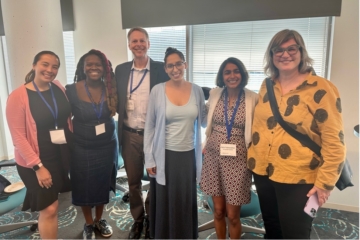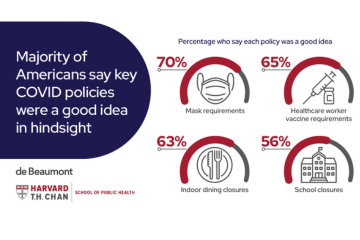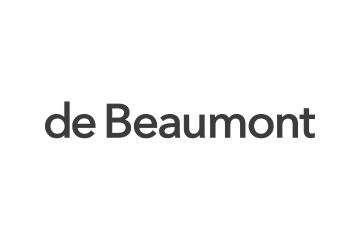
The de Beaumont Foundation’s Speaker Series highlights leaders in public health practice, advocacy, policymaking, and other related fields.
Public health has experienced a newfound visibility in the wake of the pandemic. With this increased attention comes an opportunity for the field to define itself and explain what public health means for justice and equity, according to Julie Sweetland, PhD, senior advisor at the FrameWorks Institute.
“It’s an exciting time for our sector and for the work of shaping American public consciousness,” said Sweetland during a de Beaumont Foundation Speaker Series event. “What is health other than medical care? What is it that surrounds us, that shapes our outcomes? What is it that we can do to create the environments and conditions from the start that drive your health outcomes and health equity?”
However, a collective focus on public health also makes it especially vulnerable to attacks, as the field and practitioners have become targets in the rising tide of mis- and disinformation, Sweetland explained. “Public health is among the institutions that’s not just being paid attention to, but is among the institutions that’s being pulled into culture wars and to intentional efforts to shape public and political discourse leading into the midterm elections,” she said.
It is this potential for both progress and harm that makes framing — or what we say and how we say it — essential to communication in public health. In a conversation led by de Beaumont Foundation Chief of Staff Jamila Porter, DrPH, MPH, Sweetland guided staff through the framing techniques and communication practices that public health can harness for success.
Be First, Be Right, Be Credible
The Centers for Disease Control and Prevention’s risk communication mantra, “Be first, be right, be credible,” is especially pertinent today. The growing politicization of health science issues is forcing public health practitioners to move quickly to quash mis- and disinformation. “The best inoculant against misinformation, disinformation, and manipulation of public opinion is having heard the truth first, before the disinformation gets to you,” Sweetland said.
The best inoculant against misinformation, disinformation, and manipulation of public opinion is having heard the truth first, before the disinformation gets to you.
People who may want to speak out against these distortions of truth can also benefit from public health taking the lead. According to Sweetland, “When heated rhetoric only gets one side of the story, that drives a ‘spiral of silence,'” in which people think that their own opinion is unpopular or unusual, so they become less likely to speak up against injustices or problems out of a desire to avoid conflict.
Shift Mindsets, Change Norms
Practitioners can help people understand and support public health actions when they become social norms — what is average, common, and readily understood or accepted. “To signal to people that [a concept] is a mainstream point of view, opinion, or behavior is one of the most powerful, practical, word-level things that we can do,” Sweetland said. For example, she explained, data showing that most gun owners support certain firearm safety and protection measures gives credence to gun violence prevention measures.
Sweetland pointed to FrameWorks Institute research sponsored by the Robert Wood Johnson Foundation on mindset shifts. A key example is the seemingly effortless societal shift to embracing marriage equality. But behind the scenes, achieving marriage equality involved years of multi-sector collaboration on both public opinion and public policy.
The same goes for any effort to bring about a mindset shift; it takes strategy and significant time and energy to create or change a social norm. “It’s not trivial,” Sweetland said, “but we know — and history shows — that it’s absolutely possible with the right kind of approach.”
Find Common Threads
Few people would disagree with the belief that everyone should be able to achieve their best possible health. It’s a widely appealing, universal statement, but trying to make it real — and ultimately ensuring that everyone can achieve this goal — can be complicated.
“When we talk about the targeting [people] — in terms of bringing folks experiencing a lot of hardship up to par with folks who are doing better — you have right then named two groups, and that leads into an us-versus-them, which very quickly can run into zero-sum thinking,” Sweetland said.
The solution lies in seeking the common threads that tie people together as opposed to underscoring what drives them apart, and dispelling the notion that achieving greater equity for groups who have been disproportionately harmed means less opportunity for others.
“We have to talk more about what it is we’re trying to accomplish and how we’re going to work with each and every community in the smartest, best way to get there,” Sweetland said. “The best way to get there is not walking away from equity. It’s walking away from ‘less-than’ framing.”
Defend Democracy
In an era where harmful, false narratives threaten our democracy, Sweetland has been encouraged by how time and again, people have come together to defy bad actors. But what’s most alarming now is how much these harmful narratives can be amplified.
“I think part of our solution as positive change makers has to be not only in communications, but in the ways we are using our platforms, our resources, to fix democracy again, so that moneyed interests…do not have the level of influence they have on the policymaking process,” Sweetland said.
However, looking at the progress that has been achieved offers hope, she said. Sweetland noted that research shows it’s possible for people to change their minds, which has implications for approaching policy discussions.
To learn more about framing and other topics in public health communication, visit www.PHRASES.org.




